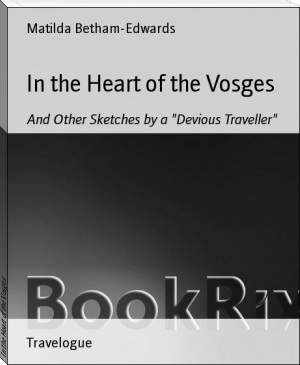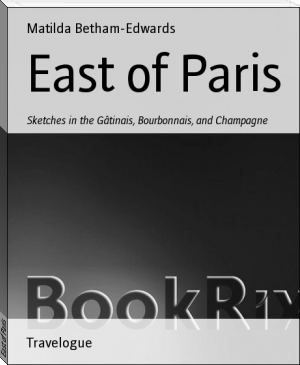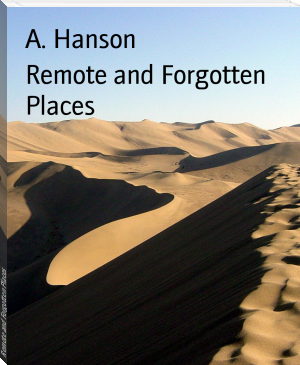Holidays in Eastern France by Matilda Betham-Edwards (best free ebook reader TXT) 📖

- Author: Matilda Betham-Edwards
Book online «Holidays in Eastern France by Matilda Betham-Edwards (best free ebook reader TXT) 📖». Author Matilda Betham-Edwards
I had fortunately no experience of hotels here, but a glance I got at the first in the place, when calling there for letters, was far from inspiring confidence. A detachment of troops was passing through the town, and large numbers of officers were lodged in the hotel, turning it into a scene of indescribable confusion. The food is said to be first rate, but the rooms looked dirty and uninviting, and the noise was enough to drive anyone out of his wits. How refreshing to find myself in this quiet Presbytere on the outskirts of the town, no noise except the occasional pattering of little feet and happy sound of children's voices, almost absolute quiet indeed from morning to night! My window looks upon a charming hill clothed with vineyards, and, immediately underneath, the large straggling garden of the Presbytere. The little church adjoins the house, and the school is also under the same roof, while the schoolmaster takes his place as a guest at the family table of the pastor. All is harmony, quiet enjoyment, and peaceful domestic life.
Ah! what a different thing is the existence of a Catholic priest from that of a Protestant pastor! On the one side, we find selfishness, sensuality, and enforced isolation from the purifying influences of home and the domestic affections; a life out of harmony with the holiest instincts of human nature, and by the force of circumstances, detrimental not only to the individual himself, but to society at large--on the other, a high standard of social and domestic virtue, a career of persistent self-denial, simplicity, and dignified obedience to the natural laws and exigencies of society, a life indeed edifying to all, and, by virtue of its unselfishness, uplifting to the individual. No one who knows French life intimately can fail to be struck by the comparison between the two, and painful it is to think how the one is the rule, and the other the exception, in this favoured land of France!
CHAPTER IX.
LONS-LE-SAUNIER.
Lons-le-Saunier, capital or chef-lieu of the Department of the Jura is charmingly situated amid undulating vine-covered hills, westward, stretching the vast plain of La Bresse, eastward and southward, the Jura range, dimpled heights changing the lofty mountain ranges into distance. The town known to the Romans as Ledo Salinarius and fortified under their auspices, also a fortified town in the Middle Ages, is dominated by four hills, conspicuously rising above its undulating environment, and each of these offers a superb view from the top. My first walk was to the height of Mont-ciel, Mons Coelius of the Romans, north of the town, and a delightful walk it is, leading us upward between vineyards to a broad open space planted with fine trees, and sufficiently large to afford camping ground for soldiers. From this summit we gain a wonderful prospect, vineyard, hill, and valley, with villages dotted here and there, picturesque mediaeval castles crowning many epochs, and far away the vast plain stretching from the Jura to Burgundy, and the majestic mountain ranges bounding on either side the east horizon. This walk is so easy that our little companion of four years old could make it without fatigue, and there are many others equally delightful, and not more fatiguing. We rested for awhile on the hill top eating grapes, then slowly descended, stopping on our way to enter the chapel of the Jesuits and school-buildings, both commanding a splendid site on the wooded incline. There were of course women in the confessionals, and painted images of saints and miracle-workers in abundance, before which people were kneeling with tiny images hugged to their breasts, like the pagans of old. Image worship, indeed, idolatry in the purest form, is carried on to a tremendous extent here, witness the number of images exposed for sale in the shop-windows.
But the excursion to be made from Lons-le-Saunier is that to the wonderful rock-shut valley and old Abbey of Baume, Baume-les-Messieurs, as it is called, to distinguish it from the town of Baume-les-Dames, near Besancon. This is reached by a delightful drive of an hour and a half, or easily on foot by good pedestrians, and is on no account to be omitted. We, of course, take the former course, having two little fellow-travellers, aged respectively four and two and a half years old, who, perched on our knees, are as much delighted as ourselves with the beauty of everything. We soon reach the top of the valley, a deep, narrow, rock-enclosed valley or gorge, and, leaving our carriage, prepare to descend on foot. At first sight, the zig-zag path along what appears to be the perpendicular side of these steep, lofty rocks, appears perilous, not to say impracticable, but it is neither one nor the other. This mountain stair-case, called the Echelles de Baume, may be descended in all security by sure-footed people not given to giddiness; our driver, leaving his quiet horse for a time, shoulders one child, my companion shoulders another, I followed with the basket, and in twenty minutes we are safely landed at the base of the cliffs we had just quitted, not yet quite knowing how we had got there! These rocky walls, shutting in the valley, or combe, as it is called, so closely that seldom any ray of sunshine can penetrate, are very lofty, and encircle it from end to end with majestic effect. It is, indeed, a winding little islet of green, threaded by a silvery stream, and rendered naturally impregnable by fortress-like rocks. We rest on the turf for a while, whilst the children munch their cakes and admire the noise of the mill opposite to us, and the dazzling waters of the source, pouring little cascades from the dark mountain-side into the valley. The grottoes and stalactite caverns of this combe are curious alike within and without, and in their inmost recesses is a small lake, the depth of which has never yet been sounded. Both lake and stalactite caves, however, can only be seen at certain seasons of the year, and then with difficulty.
The tiny river issuing from the cleft is called the Seille, and very lovely is the deep, narrow valley of emerald green through which it murmurs so musically. The mountain gorge opens by little and little as we proceed, showing velvety pastures where little herdsmen and herdswomen are keeping their cows; goats, black and white, browse on the steep rocks as securely as flies on a ceiling, and abundance of trees grow by the road-side. The valley winds for half a mile to the straggling village of Baume, and there the stupendous natural fortifications of cliff and rock come to an end. Nothing finer in the way of scenery is to be found throughout the Jura than this, and it is quite peculiar, being unlike any other mountain conformation I have ever seen, whilst the narrow winding valley of soft gold-green is in beautiful contrast with the rugged grandeur, not to say savageness, of its environment.
The buildings of this once important Abbey of Baume are now turned into a farm-house, but enough remains to bespeak the former magnificence of this most aristocratic monastery, [Footnote: Consult Roussel's "Dictionnaire de Franche-Comte" on the subject. It is very voluminous, but like any other work on Franche-Comte, may be consulted in the public library of Lons-le-Saunier without trouble or formality.] to which none could be admitted without furnishing proof of pure degree of nobility on both the paternal and maternal sides. Adjoining the Abbey is the Church, which possesses at least one chef-d'oeuvre in its retable.
This altar-piece of wood appears to belong to the fifteenth century, and is in the form of a triptych, the wings being enriched within and without by paintings in excellent preservation. The interior is divided into six compartments, in which are represented the various scenes of the life and passion of Christ. The various figures are finely sculptured, and covered with gold. Other paintings by the same artist decorate the walls of the Church.
One tomb, that of an abbe of Baume, is very beautiful, being ornamented with seven small statuettes of weeping monks, who occupy little gothic niches. The expression and attitude of these figures are touching in the extreme. All these monuments are highly interesting, and worthy of being studied in detail. The Church is disfigured by not a few modern frivolities and vulgarities.
Many objects illustrating the pre-historic and most ancient periods of French history have been found at Baume; bronze weapons and ornaments, Gallo-Roman relics, tombs, statuettes, &c., whilst a Roman camp, the largest in the Jura, has been traced on the summit of the rocks. This was destined to protect the road from Lyons to the Rhine, and occupied the height known as Mount Sermus.
Baume shared the fate of most other ecclesiastical establishments in the iconoclastic period of the French Revolution, and when we consider what the pitch of popular fury was then, we are rather tempted to wonder that anything was left, rather than that so many treasures were destroyed.
Our way home lay through the picturesque valley of the Seille, and past many places celebrated for their wines or antiquities. Vines, maize, buckwheat, potatoes, and hay covered the hillside and the plain, whilst poplar and fruit trees gave abundant shadow. We pass Voiteur, with its ruins; Chateau Chalon, ancient Celtic oppidum, renowned for its wines, like Tokay, 'veritable Madere sec Francais, genereux,' the Chateau du Pin, massive donjon perched on a hill, and still habitable, where Henry IV. sojourned, and other picturesque and interesting sites, reaching home before dusk. In fine weather the inhabitants of Lons-le-Saunier frequently make pic-nic parties to Baume, breakfasting in the valley, but, alas! fine pic-nic weather is as rare in Franche-Comte as in England this year, and autumn, always sets in early; already the mornings and evenings are really cold, and a fire would be a luxury. We do, however, get a fine day now and then, with a few hours of warm sunshine, and I had one of these for a visit to my friends living in the neighbourhood, whom I have before mentioned.
This little village in question is captivatingly situated at the foot of the first Jura range, about a mile from Lons-le-Saunier. As I have before said, throughout this entire journey, whenever I have spoken of a mountain it must be understood to mean a mountain of the Jura chain, which begins here, and only ends at Belfort, where you enter the region of the Vosges, and all along consists of the same limestone formation, only here and there a vein of granite being found. My friend's house is delightful, standing in the midst of orchards, gardens, and vines, the fine rugged peak





Comments (0)